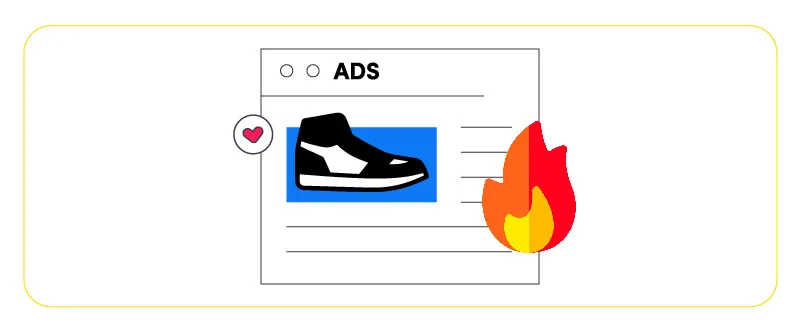A big advantage of digital advertising compared to traditional advertising methods is how flexible and accurate it is when it comes to picking target audiences for campaigns. Regardless of the digital ad format, advertisers have the ability to specify the characteristics of their intended audience and carefully control who gets to see their ads. This ability enables them to narrow down their targets to a very specific niche, or go broad and show their ads to a vast number of users. However, none of this would have been possible if it wasn’t for accumulated user data.

Advertising platforms like Google and Facebook have been collecting user data in one way or another to better understand their users and help businesses accurately target the right audiences with ads relevant to their needs, interests and demographics. An ad targeting method that’s becoming increasingly popular is picking campaign audiences based on their previous behavior. Let’s dive in to learn more about native advertising behavioral targeting and how it works.
What’s behavioral targeting?
The most common way of specifying a target audience for your campaign is filtering users out based on their demographic (i.e. age, gender, location, ethnicity, etc.). However, there’s another efficient audience segmentation method that’s proving to be much more versatile and accurate, and that’s behavioral targeting.
In behavioral targeting, instead of defining the characteristics of your preferred audience, you take advantage of each individual’s previous online behavior and interactions with your website or app to show them tailored messages relevant to their interests. The way users surf the Internet and what they read, watch, search for, and click on tell advertisers a lot about what they might be interested in both at present and in the long-term. All these data combined help create dynamic behavioral profiles for each user that’s constantly updated and customized. Advertisers could then adjust their campaign’s targeting so that ads are shown to the people with matching behavioral profiles. Let’s elaborate with an example.

Facebook Ads has one of the most powerful and sophisticated advertising platforms right now. As the most popular social network in the world, Facebook knows a lot about its users, and have gathered an enormous amount of first-party and third-party data throughout the years. When choosing target audience on Facebook Ads Manager, you have the option to filter targets based on their interests and behaviors. For example, if you have an e-commerce business that sells camping tools and accessories, you can pick people who are interested in “Camping” and “Adventure travel”.
As you would expect, behavioral targeting is only possible thanks to complex and powerful automated system and algorithms that are capable of accumulating and analyzing users’ online behavior to discover patterns and filter out irrelevant data. Behavioral targeting is similar to retargeting in terms of utilizing users’ previous activity data to show relevant ads to them. However, it’s much broader than retargeting and users much more data than just website visits.
What are the benefits of behavioral targeting?
A large part of native advertising best practices is dedicated to having the smallest possible impact on the user experience and not looking, sounding, and feeling like marketing sales pitches. That’s part of the de facto native advertising definition. Showing relevant and helpful ads to users is an inseparable part of the journey to that goal. Thanks to behavioral targeting, narrowing down your audience to people who will actually find your native ad relevant and aligned with their interest is much easier and effective. Remember that behavioral targeting is just a feature like tons of other powerful tools and features that digital advertising platforms provide. It dramatically increases your options when choosing the audience for your campaigns, so make sure to pick the right interests and behaviors based on your business type and campaign objectives. Taking advantage of a native ads spy tool for discovering the targeting properties of successful campaigns in your niche could be of great help.

Since this targeting method makes assumptions based on user’s actual behavior, there’s a higher chance they resonate with the content of your native ads and engage with it. This is a win-win scenario for both advertisers and ad recipients. Businesses could show their ads to people who are much more likely to convert and boost their return on investment (ROI). On the other hand, users get to see personalized, unobtrusive ads that might actually be useful or interesting to them.
Conclusion
Native advertising behavioral targeting provides great benefits both for advertisers and users. Businesses find much more room to create different audience segments and accurately target users who have interests that align with their field of work, and users will get to see relevant ads that might actually be useful for them. This results in higher engagement and ultimately, more revenue. Luckily, this targeting feature is getting more prominence each day and major advertising platforms are constantly improving their behavioral targeting abilities and features to provide more accuracy to their clients.
FAQs
What is behavioral targeting in native advertising?
Behavioral targeting means picking target audiences for advertising campaigns based on their previous only activity and behavior. In behavioral targeting, user’s surfing behavior is constantly tracked and relevant data is gathered, analyzed, and processed to uncover their interests. This data is later used to segment users based on their interests and behavior in advertising platforms. Advertisers could then tailor their target audience based on filters other than simple demographics. For example, flight booking businesses could target people who are interested in budget traveling.
Can I target specific user behavior with native advertising?
Of course. That’s how powerful behavioral targeting is. Many advertising platforms like Facebook have tons of behavior and interest filters that let you get really granular with your targeting and narrow down your audience to a very specific niche.
How can I measure the effectiveness of my native advertising behavioral targeting campaign?
Measuring the performance of behavioral targeting campaigns isn’t much different than other types of campaigns. Based on the objective you have set for your campaign, you need to keep track of impressions, engagements, click-through rate, and conversion rate to find out whether or not your target audience finds your ads relevant and interesting.







 Facebook Ads Spy Tool
Facebook Ads Spy Tool TikTok Ads Spy Tool
TikTok Ads Spy Tool